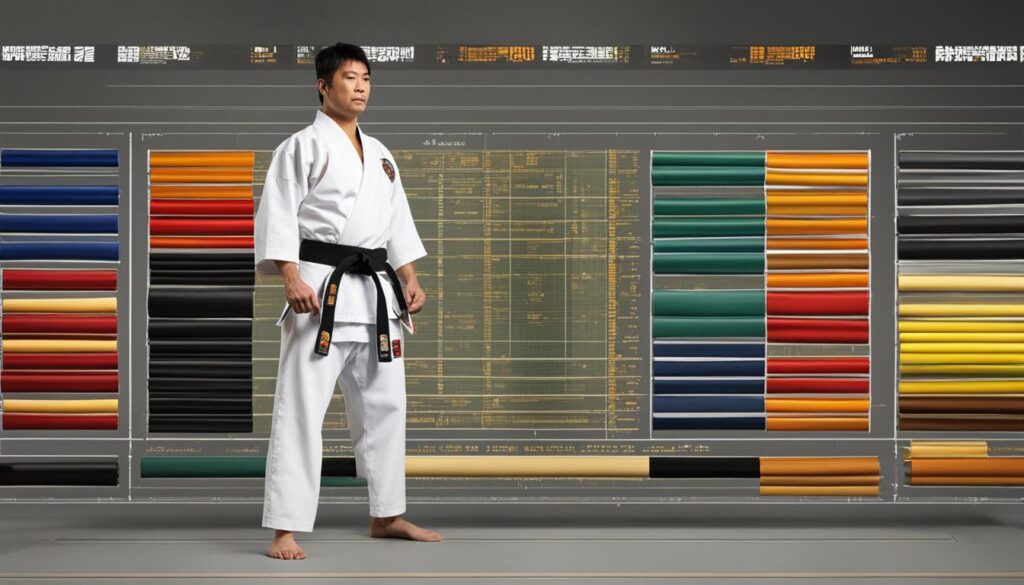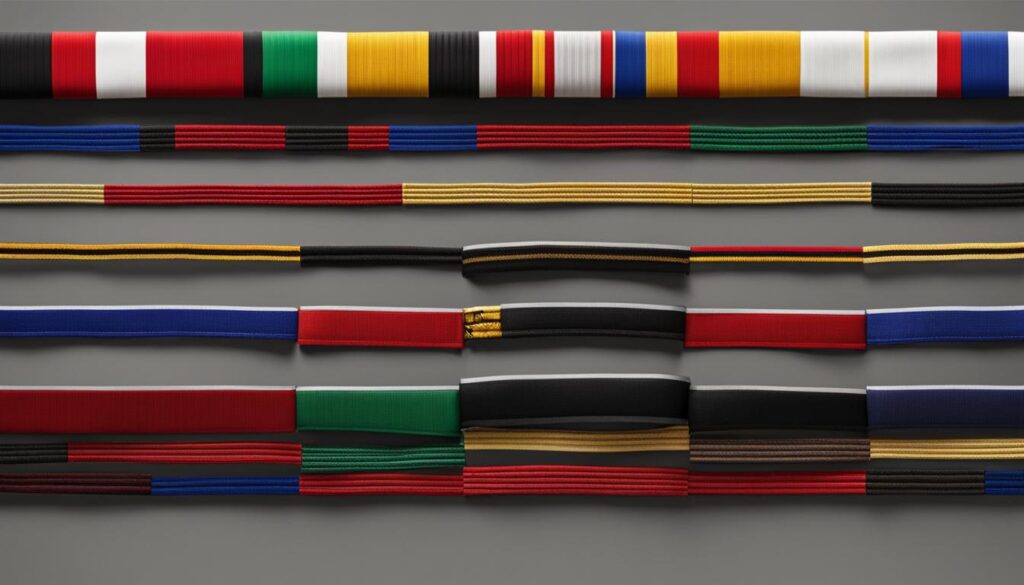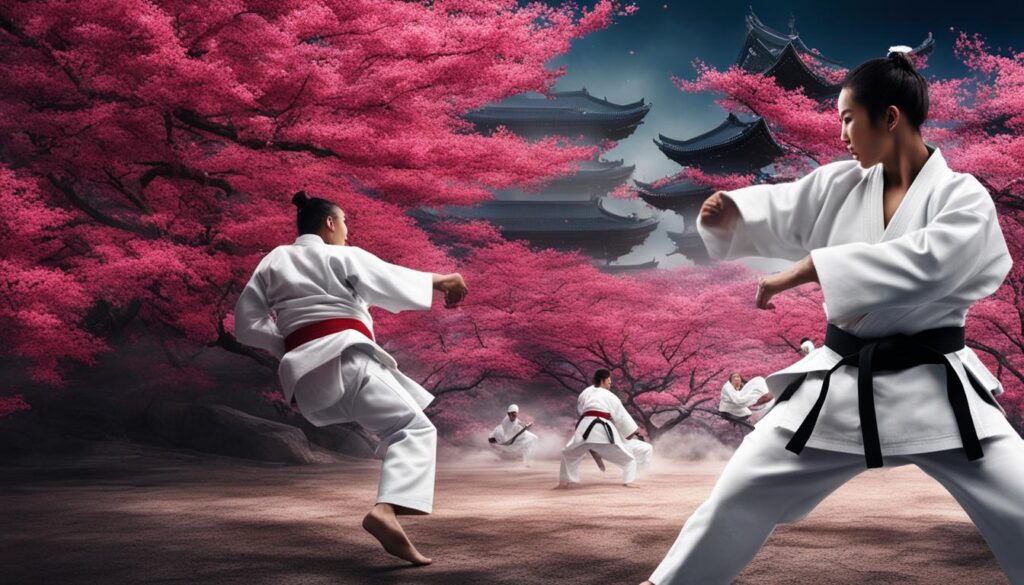Welcome to our guide on karate belt levels! If you’ve ever wondered how many belts there are in karate and what each level represents, you’ve come to the right place. The belt system in karate is a way to indicate the skill level and progress of practitioners. In this article, we’ll explore the origins of the belt system, the different belt colors and their meanings, and the journey to black belt. Let’s dive in and unlock the secrets of karate’s belt system!
Key Takeaways:
- There are varying numbers of belts in different karate styles and organizations
- The black belt is often viewed as the pinnacle of achievement, but it is just the beginning of the journey
- The belt system was introduced by Dr. Jigoro Kano, the founder of modern Judo
- Each belt color in karate has its own significance and represents progress and mastery
- The journey to black belt requires dedication, discipline, and years of training
The Origins of the Belt System in Karate
The history of karate belts is often misunderstood, with a popular legend suggesting that the belts turn black from years of practice. However, this notion lacks evidence. In reality, the modern belt ranking system in karate can be traced back to Dr. Jigoro Kano, the founder of Judo.
Dr. Kano introduced the colored belt system in Judo in the late 19th century as a way to indicate the skill level and progress of practitioners. Gichin Funakoshi, the founder of Shotokan Karate, adopted this ranking system from Judo and implemented it in karate.
It’s important to note that different karate styles have their own specific belt systems and colors. While some styles may follow a similar progression, others may have unique variations. The belt system plays a crucial role in providing structure and recognizing achievements within the karate community.
“The colored belt system in karate was introduced by Dr. Jigoro Kano, the founder of Judo.”
The Shinkyokushin Karate Belt System
In the world of Shinkyokushin Karate, practitioners progress through a well-defined belt system that signifies their growth and mastery. This belt system consists of 10 levels, known as “kyu levels” or “student levels”, each represented by a distinct belt color. Let’s take a closer look at the Shinkyokushin belt system and the significance of each belt color.
| Shinkyokushin Belt Colors | Level |
|---|---|
| White | Beginner Level |
| Orange | Progress and Basic Understanding |
| Blue | Introduction of New Concepts and Upper Body Development |
| Yellow | Solid Understanding of Karate Principles and Coordination |
| Green | Growth and Physical and Spiritual Development |
| Brown | Intermediate Mastery |
| Black | Advanced Mastery |
The journey in Shinkyokushin Karate begins with the white belt, symbolizing the start of the practitioner’s path. As they progress and demonstrate their proficiency, they advance to the orange, blue, yellow, and green belts. Each belt signifies the acquisition of new skills and the development of specific attributes.
It’s worth noting that within each belt color, dashes can be added to represent further progression. For example, a practitioner may earn a green belt with one dash, indicating a higher level of skill within the green belt rank.
Ultimately, the black belt in Shinkyokushin Karate represents the pinnacle of achievement and mastery. It is a testament to years of dedicated training and continuous growth.

As practitioners rise through the ranks of the Shinkyokushin belt system, they not only improve their physical abilities but also cultivate essential qualities such as discipline, perseverance, and mental focus. Each belt attained is a milestone, marking progress on the path to self-discovery and personal transformation.
The Meaning of Each Karate Belt Color
Each karate belt color has its own significance. Understanding the meanings behind each belt can provide valuable insights into the practitioner’s journey and progress in karate.
White Belt
The white belt represents the beginning and purity. It symbolizes the novice practitioner who is starting their journey in karate. This color signifies a blank canvas, ready to be filled with knowledge and experience.
Orange Belt
The orange belt signifies initial progress and the understanding of basic karate concepts. It represents the practitioner’s ability to grasp the fundamental techniques and principles of karate. The orange belt is an important milestone as it showcases the student’s commitment and dedication to learning.
Blue Belt
The blue belt denotes the introduction of new concepts and the development of upper body strength. It represents the progression and growth of the practitioner’s skills. At this stage, the student starts to delve deeper into the complexities of karate and further refines their technique.
Yellow Belt
The yellow belt highlights a solid understanding of karate principles and coordination. It reflects the practitioner’s ability to apply techniques effectively and demonstrates a higher level of proficiency. The yellow belt serves as a stepping stone towards further advancement in karate.
Green Belt
The green belt represents growth and physical and spiritual development. It signifies the practitioner’s progress in refining their techniques and deepening their understanding of karate. The green belt is a significant milestone as it demonstrates the growth and dedication of the student.
The Journey to Black Belt
The black belt in karate is often regarded as the pinnacle of achievement. It symbolizes expertise, discipline, and mastery of the art. However, the journey to black belt is not solely about reaching this milestone; it is a continuous path of personal growth, self-discovery, and deeper understanding of karate.
Embarking on the path to black belt requires dedication and commitment. It is a long-term endeavor that demands consistent training, perseverance, and discipline. As you progress through each belt level, you build a strong foundation of skills and knowledge that serve as stepping stones to the next stage of mastery.
Each belt color represents a specific level of progress and proficiency. From the beginner’s white belt to the advanced black belt, each step along the way brings you closer to achieving the ultimate goal. With every belt earned, you acquire new techniques, expand your understanding of karate principles, and enhance your physical and mental abilities.
As you train and advance through the belt ranks, you experience personal growth and transformation. Karate instills in you qualities such as focus, discipline, patience, resilience, and respect. These attributes extend beyond the dojo and positively impact other aspects of your life, making the journey to black belt not only about karate but also about personal development.
It is worth noting that the path to black belt is not a linear progression. There will be challenges, setbacks, and obstacles to overcome. However, each hurdle you face presents an opportunity for growth and learning. The journey to black belt teaches you to embrace these challenges, learn from them, and emerge stronger and wiser.
Remember, earning your black belt is not the end of the journey; it is just the beginning. Black belt holders continue to train, refine their skills, and deepen their understanding of karate. They become mentors and guide others on their own path to black belt, embodying the spirit of continual learning and improvement.
The Dan Ranks in Karate
In karate, the dan ranks signify advanced levels of mastery and expertise. As practitioners progress through the ranks, they gain a deeper understanding and practical application of karate techniques. The dan ranks serve as a measure of skill and are an essential part of the karate belt system.
The first dan, known as Shodan, represents a mastery of the basics. It is the first major milestone in the journey towards becoming a black belt. From here, practitioners continue to refine their techniques and expand their knowledge.
As individuals move up the ranks, they earn higher dan levels, which indicate their advanced skill and understanding. The highest dan ranks, such as Nanadan (7th dan) and Hachidan (8th dan), are reserved for those who have achieved exceptional expertise and are often seen as masters in their respective styles of karate.

The dan ranks are not solely based on time or experience; they are an acknowledgment of a practitioner’s ability to apply karate principles and techniques effectively. Each dan rank represents a new level of mastery and serves as an inspiration for continuous growth and development in the art of karate.
The Time Between Belt Examinations
When it comes to karate belt examinations, there are minimum time requirements that practitioners must meet before progressing to the next rank. These time intervals are put in place to ensure that individuals have had enough opportunities to develop and refine their skills and knowledge. The specific duration between belt ranks can vary depending on the style of karate and the organization overseeing the examinations.
One example of the time requirements between belt ranks is found in the kyu levels. For instance, there is typically a minimum of 4 months between kyu ranks. This allows practitioners to dedicate enough time to practice, learn new techniques, and demonstrate their progress before attempting the next examination.
Additionally, there is usually a longer time frame between the 1st kyu rank (the last kyu rank before reaching the coveted black belt) and the black belt rank itself. In many karate styles, there is a minimum of 12 months between these two ranks. This extended period provides individuals with ample opportunities to refine their skills, deepen their understanding of karate principles, and showcase their readiness to take on the challenges associated with achieving a black belt.
The time between belt examinations serves as a valuable period of growth and development for practitioners. It allows them to build a strong foundation of knowledge and skills at each rank before advancing to the next level. By adhering to these minimum time requirements, practitioners can ensure a well-rounded and progressive journey through the karate belt system.
Minimum Time Requirements Between Belt Ranks
| Kyu Ranks | Time Between Examinations |
|---|---|
| White Belt to Yellow Belt | 4 months |
| Yellow Belt to Orange Belt | 4 months |
| Orange Belt to Green Belt | 4 months |
| Green Belt to Blue Belt | 6 months |
| Blue Belt to Purple Belt | 6 months |
| Purple Belt to Brown Belt | 6 months |
| 1st Kyu (Brown Belt) to Black Belt | 12 months |
Belt Progression and Personal Growth
The journey through the karate belt system goes beyond achieving the next rank; it is a path of personal growth and development. Each belt earned represents a significant milestone in the practitioner’s journey towards mastery. This progression teaches valuable qualities such as discipline, perseverance, and the ability to overcome challenges.
As practitioners work their way up the belt levels, they develop not only physical techniques but also mental fortitude and emotional resilience. The practice of karate requires dedication, focus, and a commitment to continuous improvement.
Through the belt progression, practitioners learn to set goals, work hard, and push themselves beyond their limits. Each step up the ladder brings a sense of accomplishment and motivates them to strive for more. They discover the power of consistency and the value of patience as they continue to refine their skills.
Personal growth in karate extends beyond the dojo. The lessons learned on the mat often translate into everyday life, helping practitioners become more self-confident, disciplined, and centered individuals. They develop strong values, respect for others, and a sense of responsibility.
Ultimately, the karate belt progression is not just about the color of the belt but about the personal transformation that occurs along the way. It is a journey of self-discovery and self-mastery that extends well beyond the physical aspects of the martial art.
Continue reading to learn more about the influence of Judo on the karate belt system.

The Influence of Judo on the Karate Belt System
The karate belt system has been greatly influenced by Judo, thanks to Dr. Jigoro Kano. Kano introduced the kyu/dan grading system in Judo as a way to structure classes and recognize the progress of students. The kyu/dan system assigns different ranks to practitioners based on their level of skill, knowledge, and experience.
Gichin Funakoshi, the founder of Shotokan Karate, recognized the effectiveness of Kano’s grading system and adopted it for karate. Since then, the kyu/dan system has become a widely accepted and common practice in many martial arts styles, including karate.
The kyu/dan system provides a clear framework for students to track their progress and set goals for advancement. It allows instructors to assess and guide students based on their demonstrated skills and understanding. The system helps create a structured learning environment and provides motivation for practitioners to improve and achieve higher ranks.
“The kyu/dan system in karate ensures that students have a clear path to follow and a way to measure their progress. It provides a sense of accomplishment as practitioners work towards achieving higher ranks.”
Recognizing the influence of Judo on the karate belt system highlights the interconnectedness of different martial arts and the valuable contributions they have made to each other’s development. It also emphasizes the importance of acknowledging and honoring the origins and traditions that shape these martial arts practices.

The Evolution of Belt Colors in Karate
The belt system in karate has gone through an evolution, particularly when it comes to the colors used to represent different levels of achievement. Originally, the karate belt system consisted of only three colors: white, brown, and black. However, it was in 1935 that Mikinosuke Kawaishi introduced the colored belt system in Europe, which revolutionized the way ranks were recognized in karate.
Before the introduction of the colored belt system, it was difficult to visually distinguish between the different skill levels of karate practitioners. By incorporating a wider range of colors, Kawaishi made it easier to identify and acknowledge the progress made by individuals at various stages of their karate journey. This system was eventually adopted by Okinawa and Japan as well, further solidifying its significance in the martial arts community.
The History of Belts in Japanese Martial Arts
The Japanese culture has a long tradition of ranking systems in various arts, including martial arts. In Okinawa, the birthplace of karate, rankings were initially based on years of training and the development of the practitioner’s mind. The kyu/dan system was later introduced in Japan through the influence of Judo and became a standardized ranking system.
Conclusion
The belt system in karate serves as a vital tool for tracking and acknowledging practitioners’ progress and achievements. It offers a structured framework for learning and advancement, enhancing personal growth and mastery. While the number of belts and their colors may differ across various karate styles and organizations, the core principles of continuous development and self-improvement remain constant.
The renowned black belt, often perceived as the ultimate goal, represents not the culmination but rather the commencement of a new phase in the karate journey. It symbolizes the start of further exploration, growth, and refinement of skills in this ancient martial art.
By following the karate belt system, individuals gain not just technical expertise but also develop invaluable qualities such as discipline, resilience, and the ability to surmount challenges. Each belt signifies a significant milestone on the path toward mastery, fostering personal growth and character development, both on and off the mat.
FAQ
How many belts are there in karate?
The number of belts in karate varies depending on the style and organization. However, a common system is the kyu/dan system, which typically includes multiple colored belts and the black belt as the highest level of achievement.
What are the belt colors in karate?
The belt colors in karate can vary depending on the style and organization. In the Shinkyokushin style, for example, the belt colors include white, orange, blue, yellow, green, brown, and black.
What is the meaning of each karate belt color?
Each karate belt color represents a different level of progress and mastery. For example, the white belt represents the beginning and purity, the orange belt signifies initial progress, the blue belt denotes the introduction of new concepts, the yellow belt highlights a solid understanding of karate principles, and the green belt represents growth and development.
What is the journey to black belt in karate?
The journey to black belt in karate requires dedication, discipline, and years of training. It is not the end goal but rather the beginning of deeper learning and understanding in the art of karate.
What are the dan ranks in karate?
The dan ranks in karate represent advanced levels of mastery. The first dan, or Shodan, is considered a master of the basics, and as practitioners progress through the dan ranks, they gain a deeper understanding and practical application of karate techniques.
How much time is required between belt examinations in karate?
The time between belt examinations in karate varies depending on the style and organization. For example, there is typically a minimum of several months between kyu ranks and a minimum of one year between 1st kyu and black belt ranks.
What is the importance of belt progression in karate?
Belt progression in karate is not just about achieving the next rank, but about personal growth and development. It teaches discipline, perseverance, and the ability to overcome challenges, with each belt representing a milestone in the practitioner’s journey towards mastery.
What is the influence of Judo on the karate belt system?
The karate belt system was influenced by Judo thanks to Dr. Jigoro Kano, the founder of modern Judo, who introduced the kyu/dan grading system as a way to recognize students’ progress. Gichin Funakoshi, the founder of Shotokan Karate, adopted this system for karate.
How have belt colors evolved in karate?
The original karate belt system had only three colors: white, brown, and black. However, in 1935, Mikinosuke Kawaishi introduced the colored belt system in Europe, including a wider range of colors to recognize different levels of achievement, which was eventually adopted globally.
What is the history of belts in Japanese martial arts?
Japanese martial arts have a long tradition of ranking systems, including the belt system. Initially, rankings were based on years of training and the development of the practitioner’s mind. The kyu/dan system, later introduced through the influence of Judo, became the standardized ranking system.
What is the purpose of the karate belt system?
The karate belt system is a way to track and recognize the progress of practitioners. It provides a structured path for learning and advancement, and while the number and colors of the belts may vary, the underlying principles of personal growth and mastery remain constant.
